Types and varieties of arrowroot

Arrowroot is considered a vibrant and unusual tropical plant that originated in the forests of South and Central America. It has amazingly beautiful leaf colors, on which spots and veins are clearly visible. In addition to their unusual color, they can grow interestingly, change shape and direction. Shape and direction depend on lighting and other conditions.
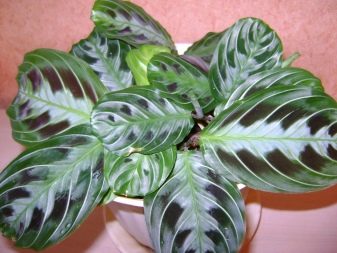

Peculiarities
This species can still grow in Western India. Various types of arrowroot can be found there, but they are not very different from each other.
This plant has a number of features.
- Height can reach from 10 centimeters to one and a half meters. But more often they do not grow higher than 20-60 centimeters.
- The root has a branched appearance, and tubers with an oblong shape can appear on thin processes.
- Shoots are either creeping or erect.
- The leaves are large: they are 6–10 centimeters wide and 10–16 centimeters long. Their shape is wide, oval, oblong or lanceolate. The color is very different - from beige to dark green and red, can be covered with dots or lines.
- Flowers are rare and appear in late May or summer. They are usually whitish and lilac in color.
- Arrowroot has an upper part of the leaves that is different from the lower one. For example, if one of them is bright green, then the other will be pink or yellow.
- The direction can be changed. If there is a good climate and proper care, then the plates are in a horizontal position. If at least some discomfort happens, then they will fold together and rise vertically.

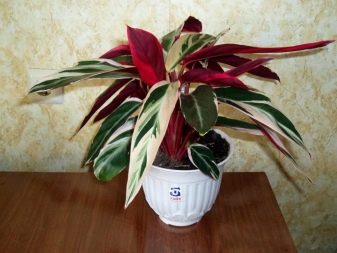


Popular indoor varieties
There are several indoor species of this flower.
- White-tailed (Maranta leuconeur). This type of flower got its name from the bright, crisp whitish veins on the leaf. The seamy part of the leaf has a burgundy purple color. The stems are short - about 16 centimeters, and the leaves, on the contrary, are wide and long - about 6-8 centimeters wide and 11-16 centimeters long. The leaves are oval with a dark green tint. There are light green patterns on the leaves, and silvery white veins are visible at the top.
This type of arrowroot can accommodate several species, which differ in the tones of the leaves.
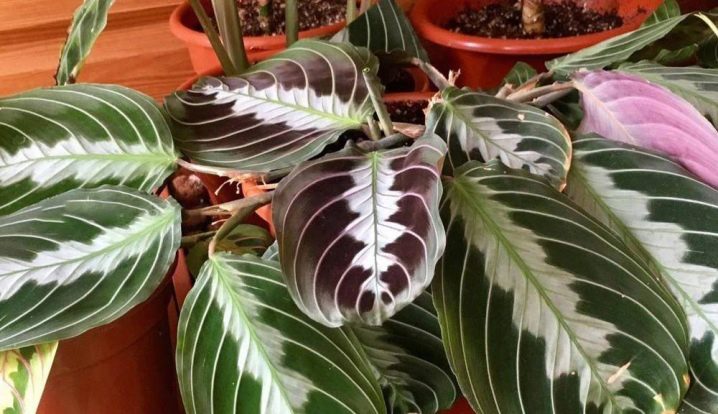
- Bicolor (Maranta bicolor). It differs in that there are no tubers on the roots and 2 basic tones are present. The flower can form a bush with a height of 21 centimeters. The leaves are arranged on long red petioles, can have an oval shape and wavy edges. The main background of the leaf is gray-green, and some of them have a dark green hue. On the entire length of the leaf, along the main vein, there are oval dark brown spots. On the back, the leaves are purple in color.

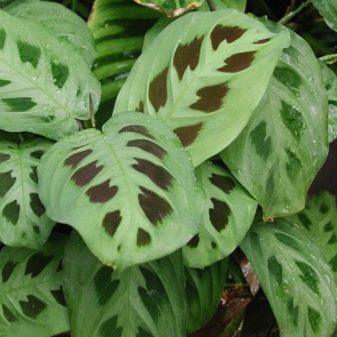
- Reed (M. arundinacea). It is very high - this arrowroot can reach a height of 1.5 meters. It has tuberous roots with starch components. It has a peculiarity - the stems dry out in winter. The leaves are long, ovate-lanceolate, and their length is 11-13 centimeters with a width of 8 centimeters. At the base, the leaf has a rounded shape, and the tip is pointed. The leaves are dark green above, below - a gray-green shade, and the flowers of this species are solitary and have a white color.

- Gibba (Maranta gibba). This species is rare, but it can be found in botanical gardens. The leaves are ovoid or oval in shape and reach a length of 11-16 centimeters. Above the leaf is velvety, and below it is smooth. The main background is light green.Dark green wide stripes are located along the main vein of the leaf. The flowers are unusual - bright, have a lilac color.

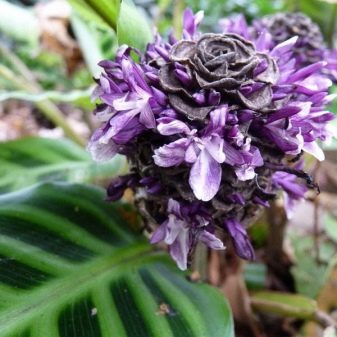
Varietal variety
White-veined plant varieties: "Fascinator" (M. leuconeura Fascinator) or "Tricolor" (M. tricolor). Tricolor is a popular variety. In well-known scientific publications about indoor plants, it is found as a red-tipped arrowroot. On the leaves, 3 shades are clearly visible: dark green in the middle of the leaf, light green at the edges, the veins have a raspberry-contrasting color. There are 10 dark spots on the sheet that form the background. For such a drawing, the flower was named "10 commandments".
This flower also has such a feature - arrowroot can turn leaves behind the sun, raise them or lower them - it depends on the light. For this feature, the variety was named "prayer grass". The flower can grow in width and length up to 31 centimeters, the stems cannot stand erect - they are hanging. The flowers of this variety of arrowroot are small in size and have a light lilac color.
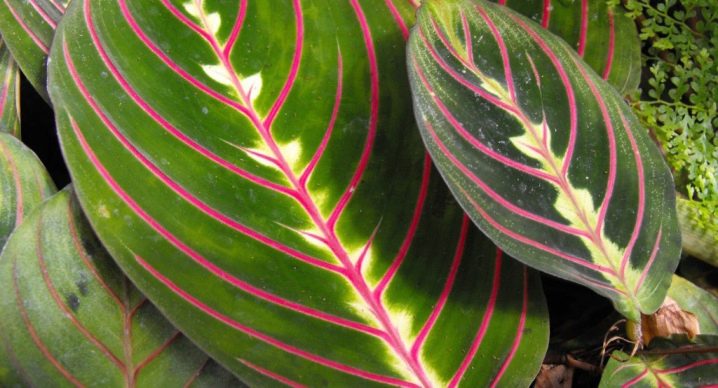
"Massange" (Maranta leuconeura Massangeana). This variety can be classified as black arrowroot because they have a dark color in the middle of the leaf. The pattern on the leaves has a contrasting shade, the edges of the leaves are green, on the sides there are light green-green stripes of lateral veins. The flower itself is miniature, has a height of 16 centimeters.
You need to take care of this variety carefully, since the variety is rather capricious.


"Marisella" (M. leuconeura Marisela). The main background is dark green. Where the central vein is located, a jagged pattern is visible, and the lateral veins are practically invisible.

"Kerhovena" (M. leuconeura Kerchoveana). It is a tall and sprawling variety. The leaves of the plant are elongated, and their length is 13-16 centimeters. The leaf plate has very bright colors. The background is bright green with dark brown strokes and eyes. The leaves have spots that do not merge into a solid mass. Below the sheet is painted in blue and red tones. This variety has a height of 26 centimeters. The flowers are small in size, dim and are collected in 2-3 pieces, have a lavender shade. The veins on the leaves have an uneven shape and do not stand out in color at all.


"Beauty Kim" (leuconeura Beauty Kim). The leaves are smooth, heart-shaped or oval-shaped, with sharp edges. The main background is light green with dark greenish mottled patterns. On the surface of the leaf there are strokes, stripes that have light green, pale yellow or white shades. A few leaves may only be half white. The patterns are located along the main and lateral veins of the leaf, but the veins themselves are dim.

"Emeral Beauty" (leuconeura Emerald Beauty). This variety is similar in color to the previous one. It has variegated shades, but the pattern is blurred, the background itself is not contrasted, there are no dark green spots. The leaves are shiny.

In addition to these varieties, there are more than 21 varieties. The varieties that were given in the article are distinguished by the bright color of the leaves. The rest of the varieties could not take root in artificial conditions.
Home care rules
Before purchasing arrowroot, you should make sure that the plant is healthy. The veins should be felt on the leaves of a healthy plant. It is better to choose arrowroot in the evening, because in the evening the plant lifts its leaves.
Then you need to carefully choose a place for the plant and immediately transplant it into a previously prepared container with soil.
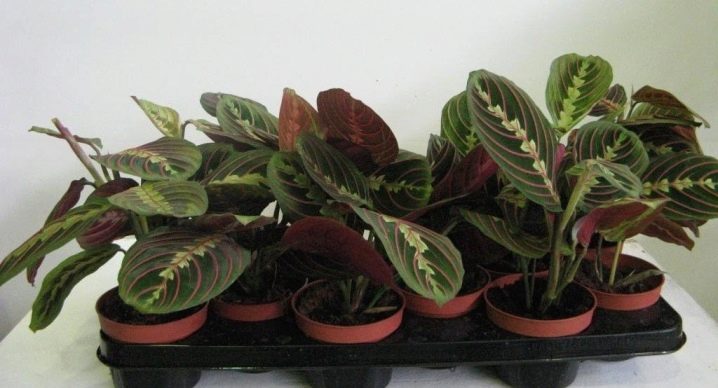
In addition, you should familiarize yourself with some rules in order to know how to properly care for arrowroot at home. And it is better to find out about this even before purchasing a flower.
- The first thing to look out for is the lighting. The plant loves shade, so if the plant is in the house, then it is better to transplant it on the windowsill, but away from the sunny side. It is recommended to protect the flower from direct sunlight, protecting it from burns, twisting of leaves and drying out. But in winter, the flower needs lighting (16 hours a day).A fluorescent lamp is used for plants at this time of the year. With a lack of light, the leaves will be thin and the stems will become too elongated.
- Arrowroot grows naturally in swamps or wet forests. Since it needs to be provided with humid air, it is better to buy a special atmospheric humidifier or spray it with water 2 times a day. But there is a drawback: the liquid contains bleach and various impurities, so arrowroot can become stained and moldy. To avoid this, it is necessary to place a flower pot on a pallet with wet expanded clay, and put wet sphagnum on top of the soil.
- Watering the flower: pour the liquid into a container and wait a little. As soon as the liquid appears in the pan, it must be poured out. When water is poured onto the plant, care must be taken to ensure that no liquid gets onto the leaves. If water accidentally gets on them, then fungus can develop and the leaves will begin to rot. To prevent this, you need to gently wipe the cuttings and leaves with a dry cloth or napkin.
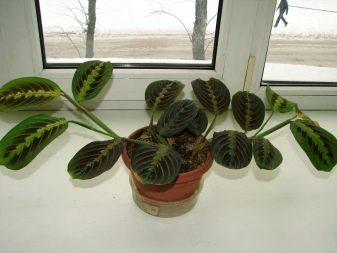

Transfer
And you also need to know the rules for transplanting a flower. At home, arrowroot needs to be transplanted 2 times a year. The pot should be wide, because the roots of the plant are shallow, a deep container will not work. You can not plant arrowroot in a pot made of ceramics, since the roots of the plant can be overcooled on the windowsill in winter.
The soil should include peat, humus, deciduous and coniferous soil. You can add charcoal to the soil. So that the arrowroot does not die from rot, drainage from expanded clay must be laid out on the bottom of the pot.
In order for the plant to grow properly, it must be pruned. In order for new and healthy leaves to grow, it is necessary to cut the leaves with cuttings and knots.
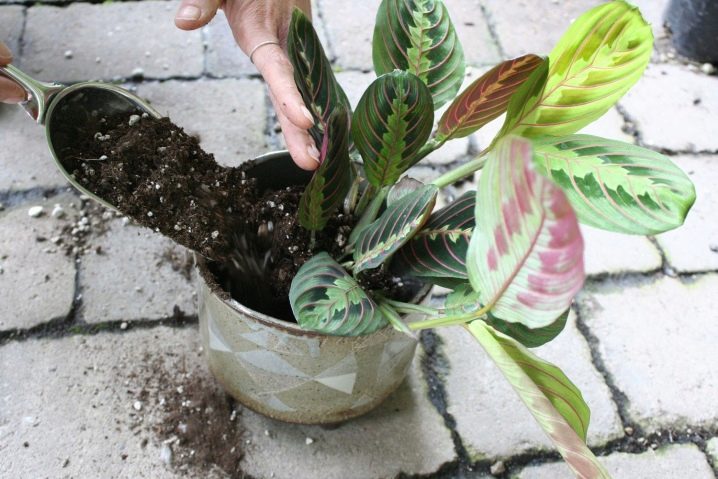
Transplanting arrowroot should include the following steps.
- It is necessary to remove the plant from the old pot, carefully clean it of soil lumps, prepare a new container, pour drainage first, and then on top - a part of the prepared soil.
- Remove old and yellowed leaves from the flower. Wipe healthy leaves from dust and debris. If the bush is large, then it can be cut at the root.
- Move the plant to a new pot, cover well with the rest of the potting mix and tamp lightly. It is important to examine the composition of the soil well before transplanting. If there is lime in the soil, then such soil cannot be purchased. Lime will negatively affect flower development.
- Now you need to pick up fertilizer and top dressing for arrowroot. Fertilizer must be added once every 14 days. In winter, you need to add only once a month. Nutrients must be added together with the liquid in a ratio of 1: 1. If the plant is at rest, it is not necessary to fertilize it, and water it 3 times less often.


Other nuances of care
You need to figure out how to prune the plant. Hygienic pruning is based on pruning dry, withered and broken leaves. Crown formation is a difficult task. It is necessary to cut off the elongated stems, but leave at least three internodes in the container and the same amount on the handle. The formation of the crown must be done once a year.
As for the temperature regime, the arrowroot always needs warmth. In summer, a good temperature is 23-25 degrees, but at the same time, overheating of the flower should not be allowed. The soil temperature should be at least 19 degrees. In cold weather, you need to make sure that the air temperature in the room does not drop below 11 degrees Celsius.
The plant reacts negatively to various drafts, so they must be avoided.

For planting and caring for arrowroot, see the next video.



























The comment was sent successfully.